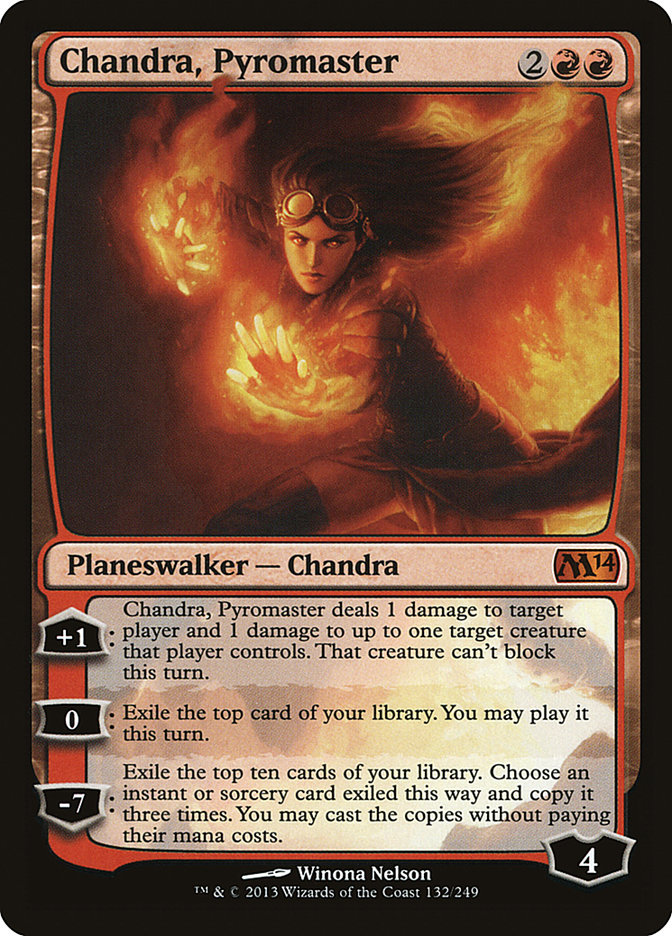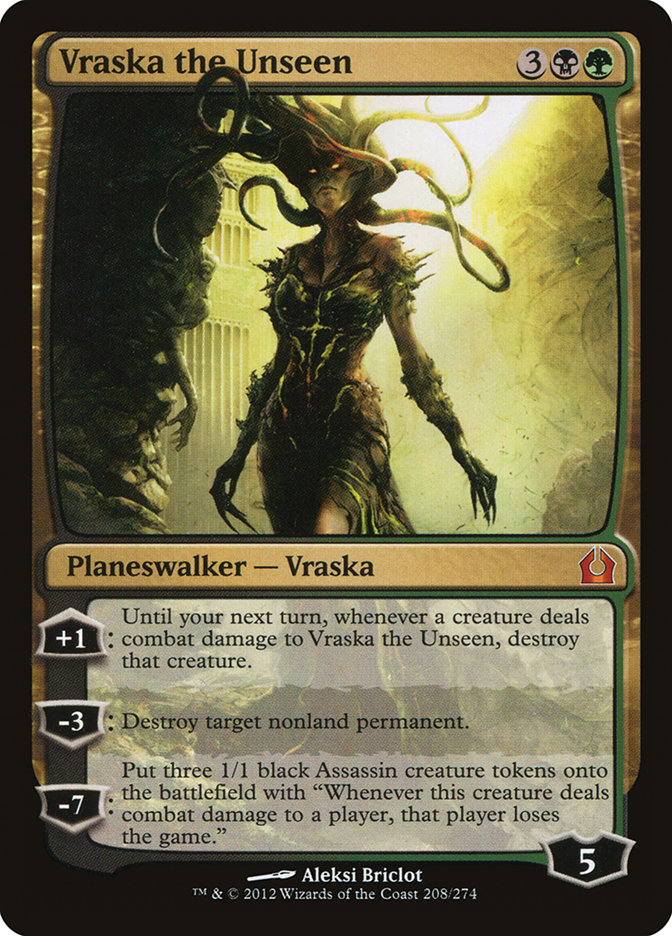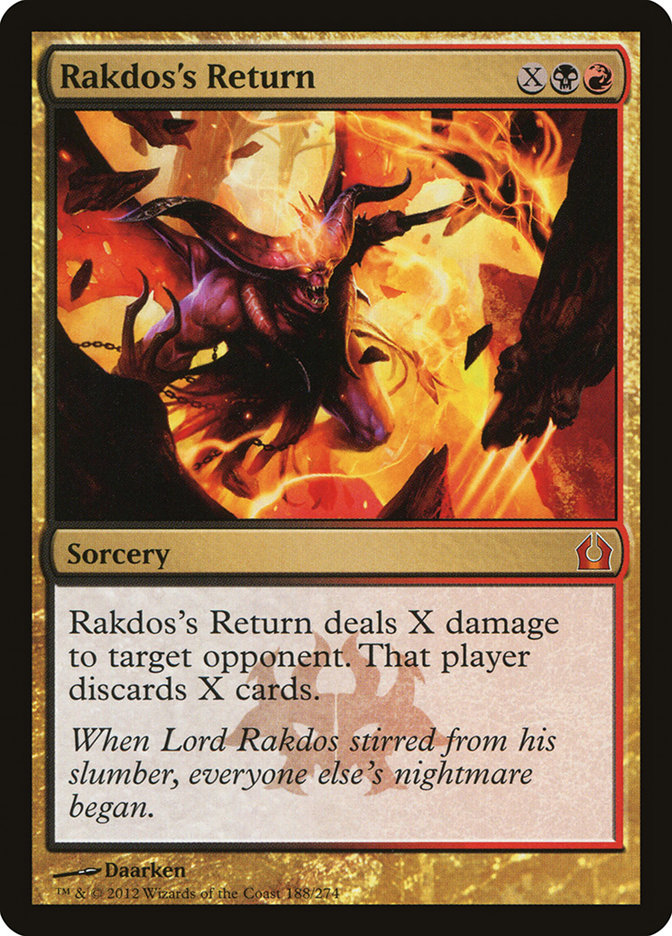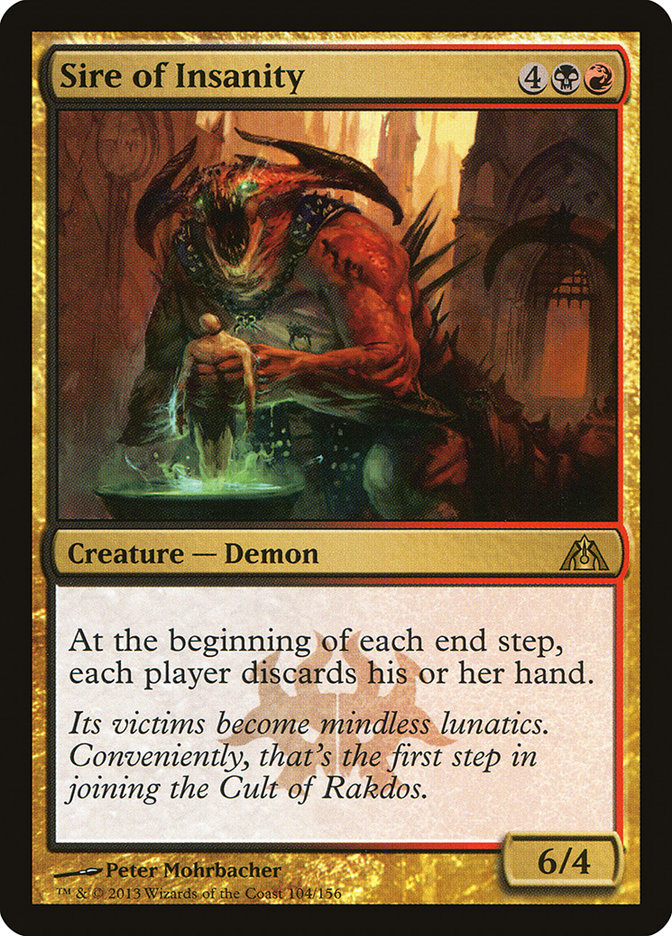As I discussed in my article last week, I tested a lot of different decks leading up to Grand Prix Cincinnati. I was getting my G/B Midrange deck into fighting shape, and I was winning far more often than not in two-player queues on Magic Online thanks in no small part to the duo of Garruk, Caller of Beasts and Sylvan Primordial.
It was actually as late as Thursday night (with a flight on Friday morning) that I decided to sanity check myself and try out a more mainstream deck. While Magic Online is a great tool for testing, it’s important to take all of your results with a grain of salt since the opposition and metagame that you face there don’t always line up with reality, especially in two-player queues, which make up most of my play time.
I shared the first stages of that final testing session in my video earlier this week, where I took Jund Monsters into battle. The list I played there was fairly typical, though in that event I eschewed Reaper of the Wilds for additional copies of Ghor-Clan Rampager. I managed to win the event I played with relative ease, and afterward I continued to play with the deck on Magic Online and kept winning. By the time I went to sleep that night, I was convinced that Jund Monsters was the deck I was going to play in the Grand Prix. While I might have been winning a lot with the other decks I was playing, I was winning basically every match with Jund Monsters.
I boarded my flight the next morning with only about 90 cards, leaving me with options for last-minute tuning and sideboard swaps, but I was locked in.
Here’s the list I played at the Grand Prix.
Creatures (26)
- 3 Scavenging Ooze
- 1 Ghor-Clan Rampager
- 4 Elvish Mystic
- 4 Polukranos, World Eater
- 4 Sylvan Caryatid
- 4 Stormbreath Dragon
- 2 Reaper of the Wilds
- 4 Courser of Kruphix
Planeswalkers (6)
Lands (24)
Spells (4)

I ended the tournament in 101st place at 10-5. My tournament looked like this:
Rounds 1-3: Byes
Round 4: Win vs. Mono-Black Devotion (4-0)
Round 5: Loss vs Mono-Blue Devotion (4-1)
Round 6: Loss vs Mono-Green Devotion (4-2)
Round 7: Win vs Mono-Red Aggro (5-2)
Round 8: Win vs Mono-Blue Devotion (6-2)
Round 9: Win vs R/W Burn (7-2)
Round 10: Loss vs Mono-Black Devotion (7-3)
Round 11:Win vs G/W Aggro (8-3)
Round 12: Win vs Esper Control (9-3)
Round 13: Loss vs U/W/R Control (9-4)
Round 14: Win vs. Esper Control (10-4)
Round 15: Loss vs Jund Monsters (10-5)
In total, I went 2-1 versus U/W-based control decks, 1-1 against Mono-Black Devotion, 1-1 versus Mono-Blue Devotion, 2-0 against red decks, 1-1 versus green decks, and 0-1 in the mirror match. While these aren’t great results, they aren’t terrible either, especially considering I only won two of my twelve die rolls to determine who plays first over the course of the weekend.
The deck felt very powerful, and I felt like I had the tools to be competitive in all of the matchups I played. Each of my losses felt close with the exception of the mirror match, where I just lost the die roll and got buried by superior draws.
A few interesting notes from the tournament:
In the first game of round 6 against my Mono-Green Devotion opponent, I had the opportunity to use the monstrosity ability on Polukranos, World Eater in game 1 to fight his Boon Satyr when he had the Satyr, a Witchstalker, and a 3/3 Experiment One in play with one Forest untapped. I decided not to because if he had Aspect of Hydra I would get blown out, which seemed like one of the reasons someone might play an aggressive mono-green deck with a card like Witchstalker.
When he attacked on his next turn, I blocked in such a way that I was resistant to the combat trick, but he had not only the Aspect of Hydra that I’d attempted to play around but also a Boon Satyr to evolve his Experiment One and increase his devotion by two in order to make his single unblocked creature lethal when I was at eleven. I was simultaneously amused that I’d played around Aspect of Hydra in the dark and felt silly for losing to it anyway.
My round 10 opponent, 2013 US World Magic Cup team member Dan Cecchetti, exclaimed out loud that my deck was full of really annoying things for him to deal with, as I had a board of Vraska the Unseen and Reaper of the Wilds and he had to Thoughtseize back-to-back Rakdos’s Return to avoid losing his entire hand. I’m fairly certain that a subtle misplay in game 1 cost me that match; I decided to play Polukranos, World Eater before Reaper in the hopes of drawing out a removal spell, only to miss an attack because he played a Desecration Demon that my Hydra couldn’t attack into while my Gorgon could have.
It’s important to note that despite how Magic Online might work, you can’t activate the monstrosity ability of Polukranos, World Eater without fighting anything, which means that you can’t attack into a Desecration Demon and hope to win the fight if they block. You have to choose at least one legal target, so if your opponent has only a Demon in play and you activate the ability for one, your Polukranos deals one damage to the Demon and dies on the spot. If you activate it for two, you have a 7/7 Polukranos with six damage on it, and your opponent can just block and trade, which is a very poor use of an entire turn.
It’s also worth noting that Magic Online also improperly handles the way Courser of Kruphix interacts with the Ravnica shock lands. When playing online, you put the land into play and then choose whether to pay the life, which means if you play a land from the top of your deck, you have the information about your next card before you make your decision. Not so in real life. The life payment is an effect that occurs as the land comes into play, which means the decision must be made before the card can move from your library zone to battlefield so you won’t have knowledge of your next card (another reason that Magic Online can be somewhat shaky to rely upon for all of your testing).
If you have any inkling that something might be working improperly on Magic Online, be sure to ask a judge about the appropriate ruling. I did exactly that when the situation came up in round 4 of the Grand Prix, and Head Judge Jason Lems confirmed my suspicion that Magic Online was wrong.
Anyway, as to the deck itself, I was very happy with most of it but certainly feel like it could be improved going forward. The success of Esper Control last weekend makes me even more certain that Jund Monsters is a great choice because I feel like the control matchup is very strong and could be even better if we try.
The card that I was the least happy with over the course of the weekend was Polukranos, World Eater. That may sound strange since Polukranos is frequently cited as one of the major reasons to play a deck like Jund Monsters and is certainly one of the most powerful cards in the deck. The thing is that while the World Eater is very good in certain worlds (presumably those upon which he dines), the world we’re living in right now isn’t one of them. A four-mana mono-green 5/5 with no immediate impact on the battlefield and no resilience to removal isn’t exactly an all-star in a world of maindeck Lifebane Zombie; Ultimate Price; Azorius Charm; Supreme Verdict; and Elspeth, Sun’s Champion.
There are certainly matchups in which Polukranos, World Eater is very good, like against aggressive white decks and Mono-Blue Devotion. But Soldier of the Pantheon frequently shows up alongside Doom Blade these days, and Master of the Waves doesn’t leave home without Rapid Hybridization. Polukranos is a powerful card, but everyone is ready for it, meaning it rarely gets the chance to chow down on any worlds. I sideboarded the big guy out in nearly half of my matches over the course of the weekend, and it wasn’t a major factor in any of my wins.
On the other hand, the cards that overperformed the most were the planeswalkers out of the sideboard: Chandra, Pyromaster and Vraska the Unseen. Whereas Polukranos, World Eater is weak against the cards people are playing to beat you, these ladies are very strong.
Chandra’s effectiveness in the current environment should come as no surprise—after all, I first contemplated playing her as a card advantage engine that kills Lifebane Zombie just after the World Championship last year when I realized I should have included her in my Standard deck over Gruul War Chant in my sideboard. Her synergy with Courser of Kruphix and Domri Rade is great, but even on her own she’s an incredible source of card advantage that can deal with one of the best cards against your deck while gaining value.
Vraska the Unseen is another card that I’ve been a big fan of for a while which fits especially well into this deck. I grew to like Vraska a lot in the early builds of my G/B Midrange deck when I realized that every deck in Standard plays heavily to the board. Even the current control decks lean heavily on permanents to both control and win the game between Detention Sphere; Jace, Architect of Thought; and Elspeth, Sun’s Champion.
I’m a big fan of minimizing the number of narrow reactive cards I play in my aggressive decks—I hate sitting with a Dreadbore in my hand and waiting for my opponent to play a target, but I also hate sitting helplessly when my opponent resolves something like Archangel of Thune. Vraska is a perfect hedge that can offer protection against creature sideboard plans while also dealing with many of the best cards to come out of both Mono-Black Devotion and Esper Control. I have yet to actually win with the ultimate in this deck, but hey, a guy can dream, right?
When I was first putting together my Jund Monsters deck, I saw a lot of lists that played two or three copies of Rakdos’s Return along with some number of Sire of Insanity and Ruric Thar, the Unbowed. I think that’s completely crazy because you certainly don’t want to have a deck full of expensive spells when you’re playing against control. I really like Thoughtseize as a sideboard option against Esper Control and the like because they frequently rely heavily on a single card like Supreme Verdict in order to beat you and being able to pick apart their hand can be extremely powerful.
That said, I think you still want some number of haymakers against them—the question is just which ones. I played Rakdos’s Return in the Grand Prix, and while it was good, it wasn’t amazing. A lot of the value of Rakdos’s Return comes from the fact that you can sideboard it in against midrange decks like Mono-Black Devotion and play it in situations where you wouldn’t necessarily want to play Sire of Insanity.
The problem I’ve found with that plan is that you can easily lose to Underworld Connections when you resolve a Rakdos’s Return, and if you’re unable to take out their entire hand, it can be too big of an opportunity cost to spend your entire turn and not actually impact the board. There’s also the fact that bringing in noncreature spells reduces the value of Domri Rade, which is otherwise one of your best cards.
One strike against Sire of Insanity is that it isn’t as reliable as Rakdos’s Return to actually knock out your opponent’s hand—it can get removed by something like Hero’s Downfall before the end step. It’s also a much more conditional card. You certainly can’t play it when your opponent is ahead, especially if they have something like Elspeth, Sun’s Champion in play. It’s also more restricted in that it always costs six mana, whereas Rakdos’s Return can often take out a Jace, Architect of Thought and knock some cards out of your opponent’s hand earlier in the game.
I’m definitely going to be testing to get a better sense of what I want as my big finishers against control and midrange decks over the next few weeks. If I were playing in a tournament this weekend, like the SCG Invitational in Charlotte, this is what I would play:
Creatures (25)
- 3 Scavenging Ooze
- 1 Ghor-Clan Rampager
- 4 Elvish Mystic
- 2 Polukranos, World Eater
- 4 Sylvan Caryatid
- 4 Stormbreath Dragon
- 3 Reaper of the Wilds
- 4 Courser of Kruphix
Planeswalkers (7)
Lands (24)
Spells (4)

It’s possible that this list needs another black source or two since shifting the four-drop focus to Reaper of the Wilds rather than Polukranos, World Eater means that you need black mana early more frequently, but I think this is a good basis. It’s where I’ll be starting my testing over the next week.
What do you think? What does the right build of Monsters look like at the moment?





